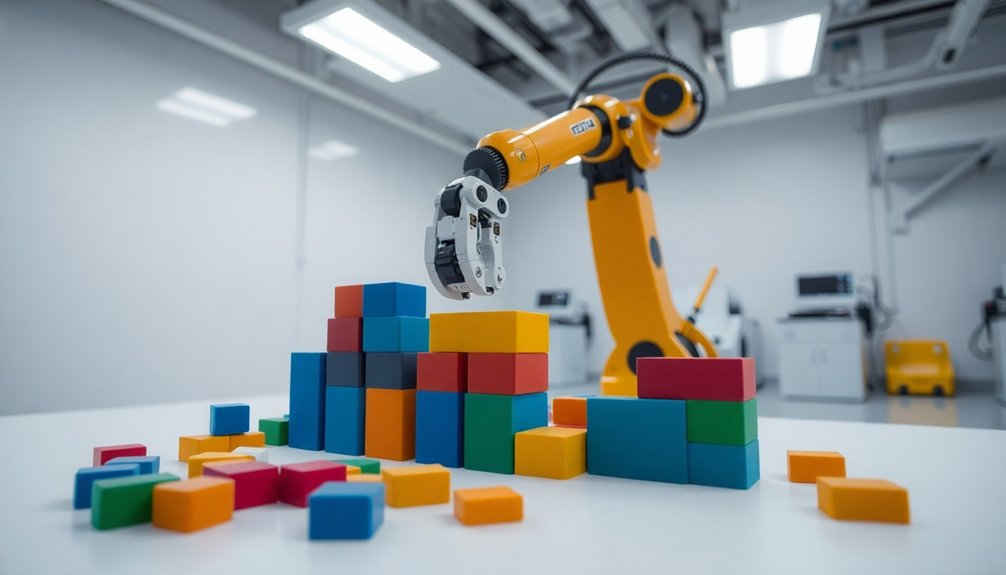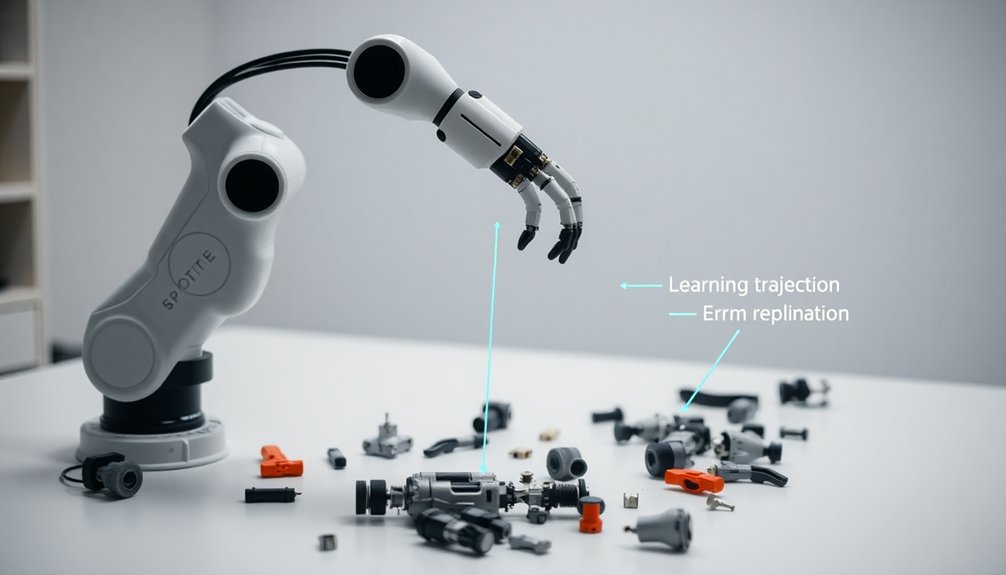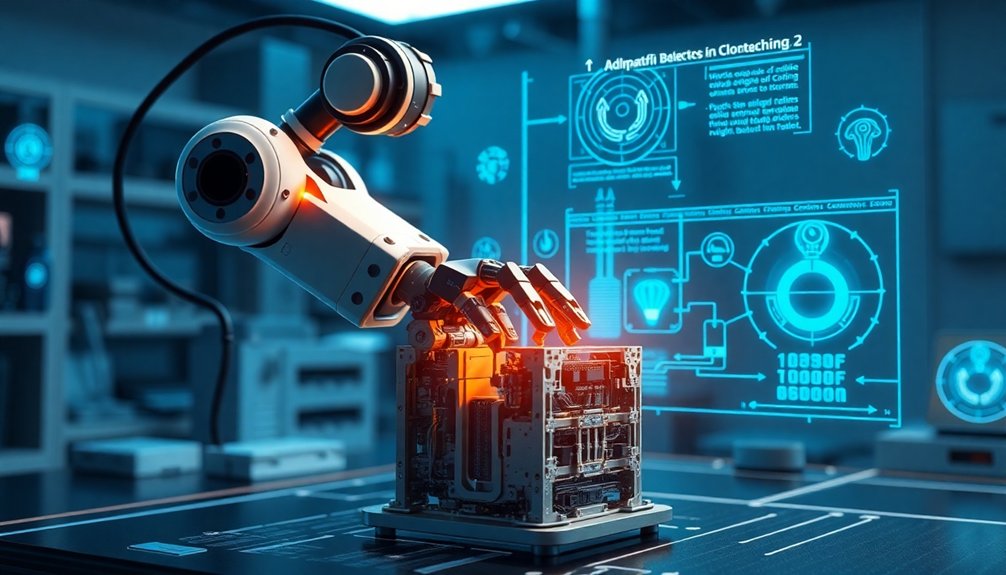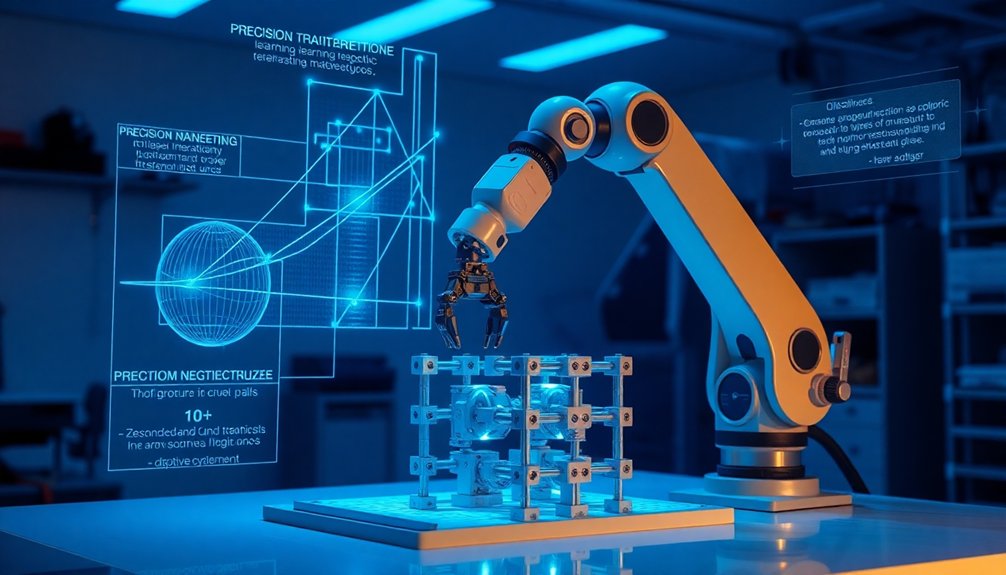Robots aren’t born smart—they learn by falling on their digital faces. Through trial and error, AI algorithms turn robot mistakes into superhero-level skills. Imagine a machine practicing thousands of times, each stumble teaching it how to move smarter. Reinforcement learning lets robots debug themselves, transforming clumsy attempts into precise movements. Want to know how a robot goes from bumbling to brilliant? Stick around, and you’ll see the future unfold.
The Mechanics of Robot Learning

While most people imagine robots as rigid, pre-programmed machines, the reality is far more dynamic.
Robot learning isn’t about downloading skills—it’s a wild dance of trial and error. Through reinforcement learning, these mechanical brains run around 10,000 simulations, starting with totally random moves and gradually building killer strategies.
Mechanical minds dancing through thousands of chaotic simulations, transforming random wobbles into precision strategies.
Think of it like a toddler learning to walk: stumble, fall, try again. Their vision systems help them spot problems, then visualize task sequences with lightning speed. What used to take 50 seconds now happens in just 5 seconds.
And here’s the kicker: robots learn from their mistakes, adapting to real-world chaos without someone holding their hand. They’re fundamentally teaching themselves, proving that AI isn’t just about following instructions—it’s about figuring stuff out. Neural networks enable these machines to absorb experiences and refine skills autonomously, transforming each failure into a valuable learning opportunity.
Reinforcement Learning: A Deep Dive
You’ve probably wondered how robots go from bumbling machines to precision performers, and reinforcement learning is the secret sauce.
By running thousands of simulations, robots fundamentally practice like obsessive video gamers, learning from each tiny mistake and gradually building smarter move sequences.
Think of it like teaching a toddler to walk: each stumble provides essential feedback, and soon enough, they’re sprinting across the room—except in this case, the “toddler” is a highly sophisticated machine learning system that can adapt to complex, unpredictable environments.
Through deep neural networks, robots develop adaptive learning strategies that transform virtual mistakes into real-world performance improvements.
Robot Training Process
Because robots aren’t born knowing how to navigate complex tasks, they need a seriously cool training method: reinforcement learning. The robot training process is like an epic AI bootcamp where machines learn through trial and error. Deep reinforcement learning helps robots evolve through experience by creating intelligent decision-making strategies.
Here’s how they transform from clumsy novices to precision performers:
- Start with 10,000 random simulation attempts
- Use a reward function that scores performance in real-time
- Reinforce successful actions and strategies
- Rapidly reduce decision-making time from 50 to 5 seconds
Imagine an AI that learns like a human but without the embarrassment. These robots create their own learning algorithm, autonomously adapting to new challenges without extensive programming.
They’re fundamentally debugging themselves, turning mistakes into opportunities for improvement. Who said learning can’t be a high-speed, data-driven adventure? Not these cutting-edge machines.
Learning Strategy Mechanics
Ever wondered how robots go from bumbling machines to precision performance artists? It’s all about learning through trial and error. High-fidelity physics simulations compress training time, allowing robots to rapidly evolve their learning strategies.
Robots can learn by running thousands of simulations, starting with random moves and gradually refining their strategies. Imagine a robotic intern who starts clumsy but becomes a pro through relentless practice.
These AI apprentices receive instant feedback—rewards for smart moves, penalties for fails—which helps them quickly adapt and improve. They’re basically digital students cramming for the ultimate exam: real-world problem-solving.
By processing around 10,000 practice scenarios, they transform from awkward novices to strategic masters. The magic? Continuous feedback that lets robots create their own learning curriculum, skyrocketing task success rates from a pitiful 2% to an impressive 64%.
Who said machines can’t learn?
Trial and Error in Robotic Systems

Imagine a robot learning like a toddler—minus the temper tantrums. Through trial and error, robots now master complex tasks using reinforcement learning that’d make your high school science teacher jealous. They’re not just following scripts; they’re adapting in real-time. Feedback loop mechanisms enable robots to continuously refine their approach based on environmental data and previous attempts.
Learning without limits: machines evolving faster than textbooks, conquering complexity through smart, spontaneous adaptation.
- Robots run ~10,000 simulations to perfect movements
- Decision-making speed drops from 50 to 5 seconds
- Random initial attempts gradually become strategic
- Autonomous problem-solving replaces pre-programmed limitations
A robot arm might start by wildly flailing, but each unsuccessful attempt teaches it something new. It’s like watching a mechanical genius go through puberty—awkward at first, but rapidly evolving.
Who needs years of programming when machines can fundamentally teach themselves? The future isn’t about perfect code; it’s about creating systems smart enough to figure things out on their own.
Simulating Real-World Scenarios
You might think robot training is just fancy computer games, but it’s way more complex than that.
Imagine trying to teach a machine how to navigate a chaotic kitchen or a construction site—you’ve got to create training environments that throw curveballs at every turn.
The key is building scenarios that are messy, unpredictable, and as close to real-world chaos as possible, so robots can learn to think on their mechanical feet. By leveraging SLAM technologies, robots can continuously refine their navigation strategies through complex simulated environments that mimic the unpredictability of real-world spaces.
Training Environment Complexity
Because reality isn’t a perfectly programmed video game, robot training needs environments that are messy, unpredictable, and downright chaotic. Your training process must embrace trial and error to master complex tasks:
- Create scenarios with unexpected obstacles
- Simulate dynamic environmental changes
- Introduce randomized challenge parameters
- Force adaptive decision-making strategies
Imagine robots learning like hyper-intelligent toddlers, bumping into metaphorical furniture and learning from each spectacular failure. By running thousands of simulations, these mechanical learners refine their movements and responses.
Advanced sensor technologies help them perceive nuanced environmental cues, turning potential mistakes into opportunities for growth. The goal isn’t perfection, but rapid adaptation.
Neural networks dynamically adapt to unpredictable environments, enabling robots to transform each simulated challenge into a learning opportunity.
You’re fundamentally teaching machines to think on their feet—or wheels—by throwing increasingly wild scenarios at them and watching how they problem-solve.
Scenario Prediction Techniques
When robots need to navigate unpredictable environments, scenario prediction techniques become their secret weapon. They’re basically running thousands of mental rehearsals, like an AI chess master plotting every possible move. Through trial and error, robots can simulate up to 10,000 scenarios, learning from each simulated mistake. Digital twin technology enables these advanced simulations by creating hyper-realistic virtual environments where robots can practice without physical risk.
| Technique | Speed | Accuracy |
|---|---|---|
| Basic Simulation | Slow | Medium |
| Reinforcement Learning | Fast | High |
| Advanced Prediction | Fastest | Highest |
Reinforcement learning transforms these robotic brains into adaptable problem-solvers. By visualizing potential challenges and running lightning-fast simulations, they cut decision-making time from 50 to just 5 seconds. Imagine a robot that doesn’t just react, but anticipates—predicting obstacles before they even happen. It’s not magic; it’s just sophisticated algorithmic problem-solving that makes these machines smarter with every simulated mistake.
Breakthrough Technologies in AI Training

If robots could learn like curious toddlers, they’d probably master new skills faster than most tech nerds could imagine. Robots learn through groundbreaking AI and machine learning techniques that make trial and error look like a superpower:
- Deep learning algorithms process raw sensory data, helping robots recognize complex patterns.
- Reinforcement learning enables robots to refine movements based on real-time performance feedback.
- Autonomous learning reduces training time from hours to mere minutes.
- Advanced technologies minimize the need for extensive task demonstrations.
Imagine a robot like BRETT figuring out how to stack Lego blocks by trying, failing, and improving — all without someone holding its metallic hand. Isaac Gym’s virtual simulation allows robots to practice thousands of movements simultaneously, dramatically accelerating their learning process.
These breakthrough technologies aren’t just making robots smarter; they’re teaching machines to think like adaptable, problem-solving creatures. Who knew mistakes could be the ultimate teacher?
Practical Applications and Case Studies
While most people imagine robots as clunky machines stuck in factory assembly lines, real-world AI is quietly revolutionizing how machines learn and adapt.
Through trial and error, robots are becoming impressively nimble learners. Take BRETT, the UC Berkeley robot that slashed learning time from hours to minutes by using smart reward functions.
Or the ALOHA system, which lets operators remotely fold clothes with robotic precision. These AI systems aren’t just mimicking human actions; they’re developing genuine problem-solving skills.
Imagine a robot that can stack Lego blocks or place clothes hangers without pre-programmed instructions—that’s not sci-fi, it’s happening now.
By running thousands of simulations, these machines are transforming from rigid automatons into flexible, adaptive technologies that can actually learn from their mistakes.
Advanced feedback loops enable robots to continuously refine their performance through real-time sensory processing and adaptive learning algorithms.
Who said robots can’t be quick studies?
The Future of Adaptive Robotics

As artificial intelligence continues its relentless march forward, adaptive robotics is poised to transform from a nerdy lab experiment into something that’ll fundamentally reshape how we interact with machines.
The future of AI-driven robots isn’t just about performing tasks—it’s about learning and adapting like curious, tireless apprentices. Consider these game-changing developments:
- Robots will learn complex tasks through continuous trial and error
- AI algorithms will dramatically reduce decision-making time
- Machines will independently develop motor skills with minimal human guidance
- Robots will achieve increasingly sophisticated task success rates
Imagine a world where robots aren’t just programmed, but actually learn and improve through experience.
They’ll watch, attempt, fail, and recalibrate—just like humans do, but without the ego bruising. The learning techniques emerging today suggest we’re on the cusp of creating machines that don’t just follow instructions, but genuinely understand and adapt.
People Also Ask About Robots
How Does AI Learn From Mistakes?
You’ll learn by trying, failing, and adjusting. AI analyzes each misstep, calculates potential improvements, and gradually refines its approach through repeated attempts, transforming errors into strategic insights that enhance future performance.
Does AI Learn Through Trial and Error?
You’ll find AI absolutely learns through trial and error, running thousands of simulations to refine strategies, adapt to challenges, and improve decision-making by analyzing successes and failures across multiple attempts.
What Is the Trial and Error Method in AI?
Imagine a toddler learning to walk by stumbling and recovering. In AI, you’ll see algorithms similarly experiment, testing actions, receiving feedback, and gradually refining strategies through repeated trials to improve performance and decision-making capabilities.
Can Robots Learn From Their Mistakes?
Yes, robots can learn from their mistakes through reinforcement learning. You’ll see them refine strategies by running thousands of simulations, adapting their actions, and progressively improving their decision-making capabilities in complex, dynamic environments.
Why This Matters in Robotics
You’ve seen robots stumble, but they’re learning faster than a toddler on espresso. Like curious kids, they’re turning mistakes into wisdom through clever algorithms and relentless practice. Trial and error isn’t just a method—it’s their superpower. Soon, robots won’t just mimic human skills; they’ll leap beyond our wildest imagination, transforming everything from surgery to space exploration. Buckle up: the adaptive AI revolution is just getting started.
